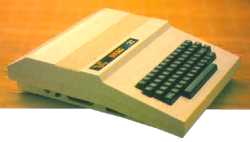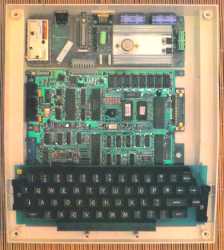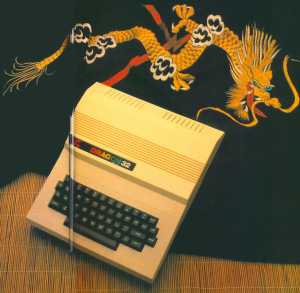If the sales hype for the new Dragon 32 is to be believed, it really is magic. Tim Hartnell looks at this new British rival to the Spectrum and rates the real keyboard and 32K RAM as good value for £200, despite flaws in the manual, and in the colour and maths ROMs. A DRAGON FOR YOUR DUNGEON |
|
|
METTOY'S NEW plaything may become a strong contender for the title of "most popular micro under £200". British-assembled and designed, around a Tandy Colour Computer ROM, the Dragon will sell for slightly less than £200. If the demand created by advertising can be satisfied Mettoy's High Street distribution should ensure that tens of thousands are sold before Christmas. Full-size keyboardFor your money you get a fairly large but light-weight unit, with full-size typewriter keyboard. There are sockets for standard joysticks, Centronics parallel printer, ordinary television or a monitor, and a slot for plug-in cartridges. The computer loads and saves on ordinary cassette machines, using a surprisingly reliable interface. |
The Dragon, which has 32K of memory, with 26K available to the user, was developed in Cambridge. The memory can be expanded to 64K. Most of the memory is available for the user; it is not consumed supporting the machine — although each graphic page in the high-resolution modes takes around 1.5K. By contrast, the Vic-20 makes available less than 6K and the BBC model A operating in mode 4 less than 4K. The Dragon offers an extensive colour Basic, with nine-colour display and high-resolution graphics, 256 by 192 in the highest mode, the same as the ZX Spectrum. There is a trade-off between the degree of resolution and the number of colours available. That is, the higher the resolution, the fewer the colours you can put on the screen at once. The Dragon can be used with a standard TV set or monitor and offers 16 rows of 32 characters display, fewer lines, but the same number of characters across, as the ZX-81 and Spectrum. |
Levels of resolutionA range of preset colour chunky graphics is available. There are five levels of resolution, point-by-point drawing, with point-by-point colour, a feature not available on the Spectrum, with commands to obtain lines, arcs and circles. There is also a fast-operating paint-in command to produce solid areas of colour. Sound output is through the TV speaker. The manual claims five octaves, 225 tones, 155 tempos and 32 volume levels. The sound is clear, but the single voice limits its potential applications. You can turn the cassette player off and on from the computer, which opens up the possibility of running a program which turns the cassette off and on at particular points. This has some good educational possibilities, such as having French words spoken from the tape as they are displayed on the screen. |
Dragon did not announce the computer until the production lines were running, in the hope of avoiding supply problems. Dragon Data is offering the machine to almost anyone who will stock it, sidestepping the extra-ordinary control over retail outlets which other companies have exercised. Will Dragon ensure that stockists know enough about the machine to help potential buyers, and those with after-sales problems? The company has already produced software on cartridge, including educational and games packages. Cartridge games include Ghost Attack, a Packman [sic] variant and arcade games such as Berserk, Cosmic Invaders and Meteoroids. All cartridges cost £19.95, except for Ghost Attack which is £24.95. This software is expensive for a £200 computer. Eight programs could cost you as much as the computer. |

Learning elementGames packs on cassette cost £8 each. The Dragon Special Selections are written in Basic whereas the cartridges are in machine code and are designed to be Listed on the screen, so you can follow through a program, to work out how it does what it does — adding an element of learning to straightforward games playing. You can learn how to construct a simple database such as a telephone list, operate a do-it-yourself calculator and try out a metric converter. Unlike many program available commercially, the Special Selections are totally transparent, so that you can follow every stage of the program and increase your knowledge of programming as you examine its listing. |
Dragon also plans to introduce personal finance programs, and a Compuvoice cassette, that will allow you to add phonetic sounds, so you can make your computer speak with a regional accent if you have the patience to program it to do so. Hardware expansion plans include a disc operating system, a serial RS-232 port, and a major operating system. The computer promises to be one of the first computers which has been properly marketed in the U.K., supported by software, standard hardware and peripherals and adequate distribution and supply. In many ways, it appears to be what the Vic-20 could have been, if Commodore has [sic] not been plagued with production problems, limited user memory and fairly coarse graphics. |
Richard Wadman's manual takes the first-time user step by step through Dragon Basic and programming. Unfortunately Wadman launches straight into difficult and boring mathematics. The moving graphics section is an improvement on the Spectrum manual. A joystick-controlled, space shoot-out game is listed and explained. However, the manual becomes very difficult to follow when it tries to explain how to use the colour. The trouble stems, in part, from Dragon's Basic. The colour is not particularly easy to use above mode 0, perhaps this is part of the price for buying an old off-the-shelf, ROM. |
Dragon may have to rewrite the colour section of the manual to make it clearer. Some of the graphics routines I tried crashed halfway through. Somehow, I had typed in something which meant the machine refused to enter any mode above mode 2. Dragon Data claimed the routines worked on five other machines. I tried the routines again a few days later, and discovered they ran perfectly. As I was using a machine with an EPROM, there may have been some subtle error which hopefully will not be present in off-the-shelf Dragons. |

CONCLUSIONS
|
|
